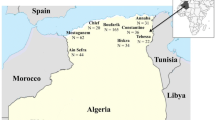Abstract
Workers of six colonies of the giant honeybee Apis dorsata from Sabah, Malaysia (five colonies) and Java (one colony) were genotyped using single locus DNA fingerprinting. The colonies from Sabah nested in colony aggregations of 5 and 28 nests respectively on two trees. Three DNA microsatellite loci (A14, A76, A88) with a total of 27 alleles provided sufficient genetic variability to classify the workers into distinct sub-families revealing the degree of polyandry of the queens. Queens mated on average with 30.17 ± 5.98 drones with a range from 19 to 53. The average effective number of matings per queen was 25.56 ± 11.63. In the total sample of 192 workers, 22 individuals were found that were not offspring of the colony's queen. Three of these were potentially drifted offspring workers from genotyped queens of colonies nesting on the same tree.
Similar content being viewed by others
References
Adams J, Rothman ED, Kerr WE, Paulino ZL (1977) Estimation of sex alleles and queen matings from diploid male frequencies in a population of Apis mellifera. Genetics 86:583–596
Blanchetot A (1992) Genetic relatedness in honeybees as established by DNA fingerprinting. J Hered 82:391–396
Chaudhary M, Strassmann M, Solis JE, Queller DC (1993) Microsatellite variation in a social insect. Biochem Genet 31:87–96
Cornuet JM, Daoudi A, Chevalet C (1986) Genetic pollution and number of matings in a black honeybee (Apis mellifera mellifera) population. Theor Appl Genet 73:223–227
Crozier RH, Page RE (1985) On being the right size: male contributions and multiple mating in social Hymenoptera. Behav Ecol Sociobiol 18:105–115
Crozier RH, Pamilo P (1995) Sex allocation and kin-selection in social insects. Oxford University Press, Oxford, UK
Estoup A, Solignac M, Harry M, Cornuet JM (1993) Characterization of (GT)n and (CT)n microsatellites in two insect species: Apis mellifera and Bomhus terrestris. Nucleic Acids Res 21:1427–1431
Estoup A, Solignac M, Cornuet JM (1994) Precise assessment of the number of patrilines and genetic relatedness in honeybee colonies. Proc R Soc Lond [Biol] 258:1–7
Evans JD (1993) Parentage analysis in ant colonies using simple sequence repeat loci. Mol Ecol 2:393–397
Gilpin M Hanski I (1991) Metapopulation dynamics: empirical and theoretical investigations. Academic Press, London, San Diego
Haberl M, Moritz REA (1994) Estimation of intracolonial worker relationship in a honey bee colony (Apis mellifera L.) using DNA fingerprinting. Insect Soc 41:263–372
Hamilton WD (1987) Kinship, recognition, disease, and intelligence: Constants of social evolution. In: Ito Y,Brown JL, Kikkawa J (eds) Animal societies: theories and facts. Japan Scientific Society Press, Tokyo, pp 81–100
Hughes CR, Queller DC (1993) Detection of highly polymorphic microsatellite loci in a species with little allozyme polymorphism. Mol Ecol 2:131–137
Keller L, Reeve HK (1994) Genetic variability, queen number, and polyandry in social hymenoptera. Evolution 48:694–704
Koeniger G, Koeniger N, Fabricius M (1979) Some detailed observations of mating in the honeybee. Bee World 60:53–57
Koeniger N, Koeniger G, Wongsiri S (1989) Mating and sperm transfer in Apis florea. Apidologie 20:413–418
Koeniger G, Koeniger N, Mardan M, Otis G, Wongsiri S (1991) Comparative anatomy of male genital organs in the genus Apis. Apidologie 22:539–552
Koeniger N, Koeniger G, Tingek S, Kalitu A, Mardan M (1994) Drones of Apisdorsata (Fabricius 1793) congregate under the canopy of tall emergent trees in Borneo. Apidologie 25:249–264
Kumar S, Tamura K, Nei M (1993) MEGA: Molecular Evolutionary Genetics Analysis, version 1.01. The Pennsylvania State University, University Park, Pa
Lindauer M (1956) Über die Verständigung bei indischen Bienen. Z Vgl Physiol 38:521–557
Lobo JA, Kerr WE (1993) Estimation of the number of matings in Apis mellifera: extensions of the model and comparison of different estimates. Ethol Ecol Evol 5:337–345
Moritz REA (1985) The effects of multiple mating on the worker-queen conflict in Apis mellifera. Behav Ecol Sociobiol 16:375–377
Moritz REA (1986) Genetics of bees other than Apis mellifera. In: Rinderer TE (ed) Bee genetics and breeding. Academic Press, Orlando, pp 121–154
Moritz REA, Southwick EE (1992) Bees as superorganisms: an evolutionary reality. Springer Verlag, Berlin, Heidelberg, New York
Moritz REA, Cornuet JM, Kryger P, Garnery L, Hepburn HR (1994) Mitochondrial DNA variability in South African honeybees (Apis mellifera). Apidologie 25: 169–178
Nei M (1987) Molecular evolutionary genetics. Columbia University Press, New York
Oldroyd BP, Smolenski AJ, Cornuet J-M, Wongsiri S, Estoup A, Rinderer TE, Crozier RH (1995) Levels of polyandry and intracolonial relationships in Apis florea are similar to those in Apis mellifera. Behav Ecol Sociobiol 37:329–335
Page RE (1980) The evolution of multiple mating behavior by honey bee queens. (Apis mellifera L.). Genetics 96:263–373
Page RE. Robinson GE (1991) The genetics of division of labour in the honey bee. Adv Insect Physiol 23:117–169
Pamilo P (1991) Evolution of colony characteristics in social insects. II. Number of reproductive individuals. Am Nat 138:412–433
Queller DC (1993) Worker control of sex ratios and selection for extreme multiple mating by queens. Am Nat 142:346–351
Schmid-Hempel P (1994) Infection and colony variability in social insects. Philos Trans R Soc Load [Biol] 346:131–321
Seeley TD, Seeley RH, Akratanakul P (1982) Colony defence strategies of the honeybees in Thailand. Ecol Monogr 52:43–63
Sherman PW, Seeley TD, Reeve HK (1988) Parasites, pathogens, and polyandry in social Hymenoptera. Am Nat 131:602–610
Woyke J (1956) Anatomo-physiological changes in queen bees returning from mating flights and the process of multiple mating. Bull Acad Pol Sci Cl 2 4:81–87
Woyke J (1975) Natural and artificial insemination of Apis cerana in India. J Apic Res 14:153–159
Author information
Authors and Affiliations
Additional information
Communicated by R.H. Crozier
Rights and permissions
About this article
Cite this article
Moritz, R.F.A., Kryger, P., Koeniger, G. et al. High degree of polyandry in Apis dorsata queens detected by DNA microsatellite variability. Behav Ecol Sociobiol 37, 357–363 (1995). https://doi.org/10.1007/BF00174141
Received:
Accepted:
Issue Date:
DOI: https://doi.org/10.1007/BF00174141



